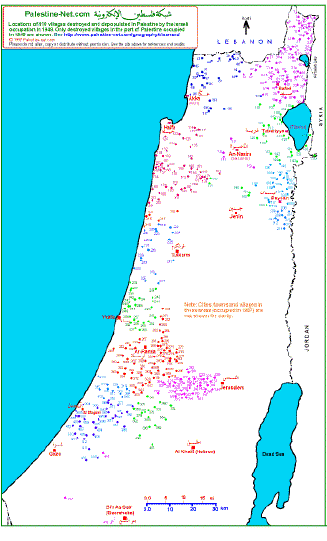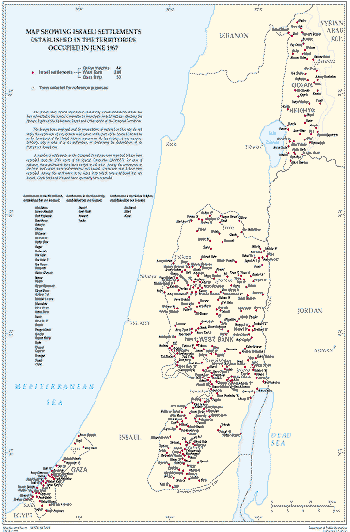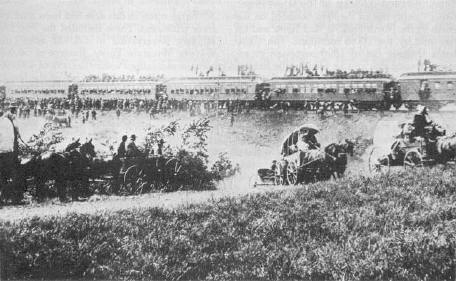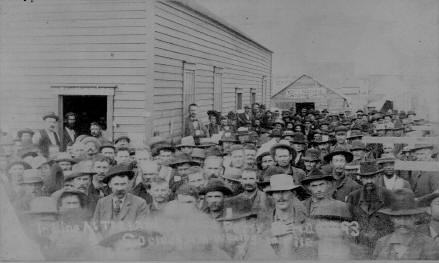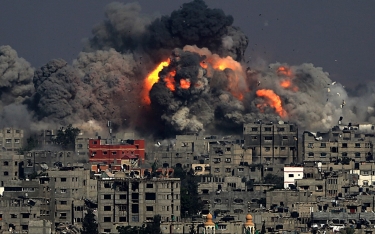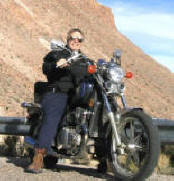|
Furthermore,
like the American Indians, faced with the overwhelming economic,
political and military forces lined up against them, many Palestinians
have turned to a religious ideology --militant fundamentalist
Islam-- that unites them as a people in their opposition to Israel
and the U.S., which they see as the principal supporter of Israel in the
world today. In addition, just as the Indians turned to
spiritual/political leaders such as Crazy Horse, Sitting Bull Tecumsah,
Tentswakawa and Neolin in their resistance to American colonization, so
also have many Palestinians and other Muslims turned to
religious/political movements and leaders that personify their
opposition to what they perceive as Israeli colonialism and American
neocolonialism, including Hamas and Hezbollah. And just as the Israeli and U.S. Governments today consider
it necessary to eliminate radical Islamists, who they perceive as a
threat to regional and global political stability, the U.S. Government
considered it necessary to remove and arrest Sitting Bull, Crazy Horse,
Geronimo and other Indian leaders who they believed threatened the peace
in the 19th century.
By
studying revitalization movements such as the Ghost
Dance,
we can better understand similar movements elsewhere. American
colonization, for example, had a similar effect on the indigenous
Hispanic population of New Mexico, which had occupied that region for
over 200 years. Political resistance emerged among the Hispanic
population almost immediately following American occupation of New
Mexico, and it took both political and religious forms.
Similarly, Spanish colonization of the Southwest led to the Great
Pueblo Revolt
in 1680 in which all of the Pueblo villages throughout Arizona and New
Mexico united under a prophet named Pope'` to expel the Spanish from
their land. Similarly, Jewish dissatisfaction with both Greek
and Roman colonization led to several instances of religiously
inspired political and military revolt --beginning
with the Macabbeean
Revolt
in the second century BCE, through to the revolt under Bar
Khova
in 132 CE. Indeed, the
Jews waged an almost continuous resistance to Roman colonization of
Palestine during the entire first century CE. Similarly, it would
be impossible to understand the origin of Christianity if it were not
viewed within this context (see
The
Jesus Movement).
*
* *
* *
The direct occupation of the territory of a conquered people was
recommended by Machiavelli as one of the most effective means for controlling
conquored land
and the subjugated people on that land. According to Machiavelli,
Unless
you establish settlements, you will have to garrison large numbers of
mounted troops and infantry. Settlements do not cost much and . .
.(they can be established and maintained) . . . at little or no personal
expense . . . (to the political leaders). . . . settlements
are economical and more faithful, and do less harm; and those who are
injured cannot hurt you because . . . they are scattered and poor.
(Machiavelli, The Prince, p. 10)
Both
the U.S. and Israel have adhered to Machiavelli's directive. The
U.S. passed the Homestead
Act
in 1862. As a result of this act, over 270 million acres of former
Indian land was made available to American citizens. Any head of
household at least 21 years of age could claim a 160 acre parcel of
land. The Homestead Act produced many a "land rush" like
the one pictured below and resulted in the complete U.S. occupation of
Indian lands. Most of the land that has been set aside for Indians
is only a fraction of their former territories. Moreover, most
Indian reservations were reduced in size as the expanding American
population required more land and resources. As a result, most of
the land that was eventually given to Indians was "marginal"
land that was not desired by whites. Furthermore, the colonization
of North America by Euroamerican immigrants was rationalized and justified
through recourse to the doctrine of
Manifest
Destiny,
the belief that colonization of the entire continent was a mission
ordained by God.
Scenes of the Oklahoma Land
Rush, 1889
The
Israeli Government has followed a similar policy. The Israeli
Government has, like the U.S., promoted an aggressive immigration program,
which brings Jewish settlers to Israel. These immigrants are the
primary colonists of the new settlements in the occupied
territories. As Machiavelli noted, the settlements are "more
faithful".
They are more supportive and less critical of government policy with
regard to Palestinian land, just as those living in the American West were
more committed to the occupation of Indian land than were those living in
the East. Indeed, the settlers --Israeli and American--
owe/owed their homes and their livelihood to that policy. It would
hardly be in their interests not to support it. Israel also uses an
ideological/religious justification for its colonization in the form of
Zionism:
the belief that the colonization
of Palestine represents a reclaiming of the Biblical Kingdom of Israel. As with the
Indian-White conflict that occurred throughout the American
West, Israel has been the scene of numerous
violent confrontations between settlers and the Palestinians who have lost
their land, as well as of an ongoing resistance by the Palestinians to the
Israeli Government. Both sides see themselves as the victims of the
other side's violence. This should not be surprising. The
Americans and the Indians viewed each other in much the same was as do the
Israelis and Palestinians.
*
* *
* *

The
lesson in all of this is very simple: while specific events of
history do not repeat themselves, the
processes that create history
certainly do. While many people frequently
repeat the above statement as a warning against people acting today in a
way that will result in outcomes
that have occurred in the past, the statement does not reflect a realistic
view of the causes underlying historical and contemporary social
behavior. The implication is that people are able to control the
social situations in which they find themselves and to make different
choices. How likely is it that individuals who are directly
involved in a situation involving social or political conflict are able to
stand outside that situation and view it objectively? Isn't one of
the assumptions of thinking in social
science terms that
a given set of circumstances will likely (i.e., predictably) lead to a
given set of consequences
("given a, . . . then b")?
Haven't comparable situations, including ethnic conflict, genocide and
warfare, recurred repeatedly throughout history precisely because people
will respond predictably to similar circumstances in similar ways?
Can we realistically expect people to act otherwise? Is there
research which suggests that alternate behaviors and reactions could
realistically be expected? What implications does the research on
social and ethnic conflict have for both our understanding of that
conflict and for developing and implementing public policy?
*
* *
* *
Here is a recent article on the
expansion of
Israeli settlements from The
Economist:
West Bank settlements
Swallowing
all before them
Oct
31st 2002
The Economist
Despite the
intifada, Israel intensifies colonization of the West Bank
KNOWING that it will take more than a cut in subsidies to reverse what
they see as the gravest threat to their dream of a viable state,
Palestinians were underwhelmed by the Labour Party's decision to leave
Ariel Sharon's coalition over the money that the Israeli government
proposes to spend on settlements. There are now 123 Jewish settlements in
the West Bank, and 12 in occupied East Jerusalem, housing some 380,000
settlers who share the territory with 2.4m Palestinians. They do not share
it equally.
|
According to a recent study by B'Tselem, an Israeli human-rights
group, the West Bank settler population doubled in size during the
seven-year Oslo peace process, and the settlements' territorial reach
has now been extended to cover nearly 42% of the West Bank. This huge
expansion has been achieved largely through the construction of
settler-only bypass roads and military zones which serve to integrate
the settlements with Israel proper.
What was interim during Oslo has become
formalised during the intifada, says Yehezkel Lein, a B'Tselem
researcher. Under the fire of conflict, settlements, roads and zones
have in effect become Israel's new military borders in the West Bank,
enabling the army to isolate Palestinian villages one from the other,
and to reoccupy six of the eight main Palestinian towns.
The changes are most noticeable along Israel's
northern border with the West Bank and around East Jerusalem, two
areas Israel seeks to annex in any final settlement with the
Palestinians. This is where most of Israel's settlement expenditure is
being concentrated, says Mussi Raz, a member of the Knesset from the
left-wing Meretz Party. Chunks of the northern West Bank have been cut
off by the “security fence”—actually a grid of barriers, roads,
trenches and sensors—that it is now being created along the pre-1967
border. |
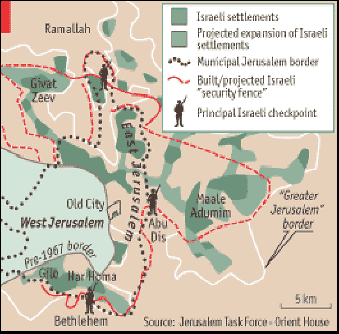
|
Around East Jerusalem, the fence is mapped to go
even deeper into the West Bank. Palestinians fear that it will eventually
envelop not only the East Jerusalem settlements (which the Israelis do not
count as settlements as they long ago unilaterally annexed the city) but
also vast urban blocks, such as Maale Adumim, in the West Bank. The
result, they say, will be to cut off the 276,000 Palestinians in East
Jerusalem and its environs from their West Bank hinterland. Moreover, the
implantation of Jewish enclaves within the densely populated Palestinian
areas in and around the Old City is being encouraged with government
money.
|
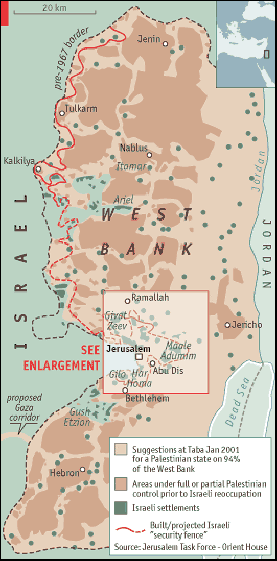 |
This mixing of populations is presumably intended to prevent any
return to the “understandings” on Jerusalem reached by Israeli and
Palestinian negotiators, especially at the Taba talks in January 2001.
It is, says Menachem Klein, an adviser to the Israeli delegation at
the talks, Mr Sharon's answer to Bill Clinton's “parameter” that what
is Jewish should be Israeli, and what is Arab should be Palestinian.
A similar logic appears to be behind the 100 or so settler outposts
that now pepper the West Bank, and whose “illegal” establishment
Binyamin Ben-Eliezer, the Labour leader and departing defence
minister, had at last decided to reverse. Begun as caravans on tops of
hills, the outposts often develop into “legal” settlements.
Take Itamar, a settlement near Nablus. Home to fewer than 500
settlers, it has established seven outposts, some ten kilometres (six
miles) beyond its built-up area. Earlier this month, the last families
from the neighbouring Palestinian village of Yanun were forced to
leave their homes after years of armed harassment from Itamar's
settlers. It was the first full evacuation of a Palestinian village
since the 1967 war.
The Palestinians ask for a full freeze on
settlement construction as a first step to their evacuation or
dismantlement. They presented this demand to William Burns, the State
Department's special envoy, when he was in Jericho last week. Mr Burns
is touring the region with the draft of a “roadmap” to resolve the
Palestinian-Israeli conflict within three years. Among a slew of other
demands, the roadmap calls for dismantling the outposts by December,
and a freeze “on all settlement activity” by next May. But
Palestinians believe that only a handful of the outposts will be
removed, and Mr Sharon has consistently ruled out a freeze.
|
*
* *
* *
Of Related Interest . . .
*
* *
* *
|
